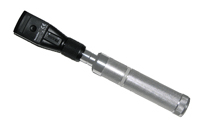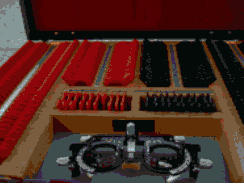
Eye Examination
At Tokyo OpticiansWe recommend to you have an Eye Examination at least once in year, or more frequently as the Condition demands . There are many different ways to test your eyes; our Opticians select the tests most appropriate for you. The Eye Examination not only provides an accurate assessment of your ability to see, but also analyses the general health of your eyes – and can result in early identification of other eye problems related to systemic diseases like diabetes and hypertension.
Visiting the Opticians
Our customer data base executive makes sure that your confidential customer record is accurate and up-to-date. On your re-visit we will be able to retrieve your old records for the reference, then our Optometrist analyzes / Diagnoses the ocular Condition accurately in shortest possible time and comes up with the Advise/Prescription.
About your health and lifestyle
The optometrist/optician asks questions about your health, your family’s health, your work and your lifestyle. It is very important to have a clear understanding of your vision needs, especially if a specific problem is the reason for your visit.
Vision Tests
Vision tests measure your ability to see details at near and far distances, and evaluate your ability to see different colors. The tests usually involve reading letters or looking at symbols of different sizes on vision charts. Usually, each eye is tested separately.
Refraction
 Objective Refraction is a test that measures the eyes’ need for corrective lenses. It is usually done after a Vision test. Refractive errors, such as Short Sightedness, Long Sightedness and Astigmatism occur when light rays entering the Eye can’t focus exactly on the retina at the back of the eye. This causes diminished vision. Refraction is done as a routine part of an eye examination for people who already wear glasses or contact lenses, but it will also be done if the results of the other visual acuity tests show that your eyesight is below normal and can be corrected by glasses. The Auto Refractometer is an Automatic Machine which takes an electronic measurement of how well your eyes focus and gives a reading / approximate prescription for the optometrist to use.
Objective Refraction is a test that measures the eyes’ need for corrective lenses. It is usually done after a Vision test. Refractive errors, such as Short Sightedness, Long Sightedness and Astigmatism occur when light rays entering the Eye can’t focus exactly on the retina at the back of the eye. This causes diminished vision. Refraction is done as a routine part of an eye examination for people who already wear glasses or contact lenses, but it will also be done if the results of the other visual acuity tests show that your eyesight is below normal and can be corrected by glasses. The Auto Refractometer is an Automatic Machine which takes an electronic measurement of how well your eyes focus and gives a reading / approximate prescription for the optometrist to use.The retinoscope
 The optometrist may use an instrument called a Retinoscope, to find out Refractive error. The Retinoscope is very accurate instrument in finding of Refractive errors. It is more helpful especially for small children, or people with communication difficulties who can’t easily describe how clearly they can see.
The optometrist may use an instrument called a Retinoscope, to find out Refractive error. The Retinoscope is very accurate instrument in finding of Refractive errors. It is more helpful especially for small children, or people with communication difficulties who can’t easily describe how clearly they can see.Subjective refraction
 Where the result depends on the patient’s ability to distinguish changes in clarity, this process relies on the Cooperation of the patient. The optometrist fine-tunes his findings by asking you to read the test chart through different strengths of lenses. The results for one eye may vary from the other, so each eye will be tested individually before both eyes are finally tested together. The optometrist flips different lenses in front of your eyes that change how clearly you can see. Depending on your answers, he changes the lenses until you have the clearest, most comfortable vision possible.
Where the result depends on the patient’s ability to distinguish changes in clarity, this process relies on the Cooperation of the patient. The optometrist fine-tunes his findings by asking you to read the test chart through different strengths of lenses. The results for one eye may vary from the other, so each eye will be tested individually before both eyes are finally tested together. The optometrist flips different lenses in front of your eyes that change how clearly you can see. Depending on your answers, he changes the lenses until you have the clearest, most comfortable vision possible.Using the ophthalmoscope
 The optometrist uses an ophthalmoscope to examine the retina at the back of the eye, including the blood vessels and the front of the optic nerve. This important test can detect changes which can indicate diseases such as diabetes or high blood pressure. The optometrist darkens the room and sits quite close to you, while he shines a bright light into each eye in turn using the ophthalmoscope. The light may leave shadows on your vision, but these soon fade
The optometrist uses an ophthalmoscope to examine the retina at the back of the eye, including the blood vessels and the front of the optic nerve. This important test can detect changes which can indicate diseases such as diabetes or high blood pressure. The optometrist darkens the room and sits quite close to you, while he shines a bright light into each eye in turn using the ophthalmoscope. The light may leave shadows on your vision, but these soon fadeThe slit lamp
 The slit lamp is a powerful, illuminated microscope that is used to examine the Anterior segment of your eyes – the cornea, Conjunctiva, sclera, iris, anterior chamber and the lens – to check for the abnormalities.
The slit lamp is a powerful, illuminated microscope that is used to examine the Anterior segment of your eyes – the cornea, Conjunctiva, sclera, iris, anterior chamber and the lens – to check for the abnormalities.This is a very important test for Contact Lens wearers
Discussing your needs
The optometrist will try to answer your queries during the eye examination, and will explain his findings. If he considers that you would have clearer vision with a change of prescription or new glasses, he will explain why and recommend the best options.
Choosing your glasses
 After your eye examination, your optometrist will pass on his findings and recommendations to a dispenser, who will help you to choose your new Pair of Spectacles.
After your eye examination, your optometrist will pass on his findings and recommendations to a dispenser, who will help you to choose your new Pair of Spectacles.
